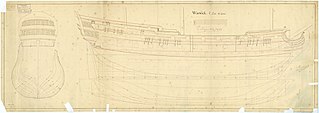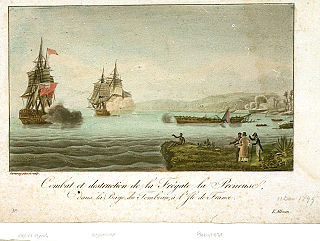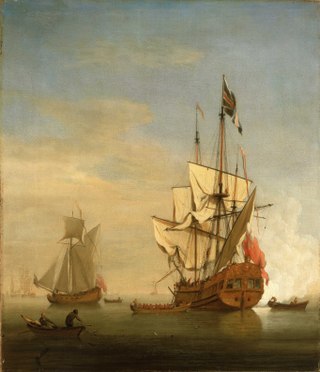
HMY Fubbs was a Royal Yacht of the Royal Navy of the Kingdom of Great Britain. She was scrapped towards the end of the eighteenth century after having been in service for 99 years.

HMS Centurion was a 60-gun fourth rate ship of the line of the Royal Navy, built at Portsmouth Dockyard by Joseph Allin the younger and launched on 6 January 1732. At the time of Centurion's construction, the 1719 Establishment dictated the dimensions of almost every ship being built. Owing to concerns over the relative sizes of British ships compared to their continental rivals, Centurion was ordered to be built 1 ft (0.3 m) wider across the beam than the Establishment prescribed. HMS Rippon was similarly built to non-Establishment dimensions at the same time.

HMS Arrogant was a 74-gun third rate ship of the line of the Royal Navy, built of Suffolk oak by John Barnard and launched on 22 January 1761 at King's Yard Harwich. She was the first of the Arrogant-class ships of the line, designed by Sir Thomas Slade.

HMS Cambridge was an 80-gun third-rate ship of the line of the Royal Navy, designed by Sir Joseph Allin and built at Deptford Dockyard by Adam Hayes to the draught specified by the 1745 Establishment as amended in 1750, and launched on 21 October 1755.

HMS Gladiator was a 44-gun fifth-rate Roebuck-class ship of the Royal Navy. She was launched on 20 January 1783 by Henry Adams of Bucklers Hard. She spent her entire career on harbour service, never putting to sea. Even so, her crew earned prize money for the seizure of two Russian and five American ships. Her sessile existence made her an excellent venue for courts-martial and a number of notable ones took place aboard her. She was broken up in 1817.

HMS Warwick was a 60-gun fourth-rate ship of the line of the Royal Navy, built to the 1719 Establishment at Plymouth by Peirson Lock. The keel was laid down on 1 April 1730, and the ship was launched on 25 October 1733, and completed on 24 August 1734.

HMS Inconstant was a 36-gun Perseverance-class fifth-rate frigate of the Royal Navy. She had a successful career serving in the French Revolutionary and Napoleonic Wars, capturing three French warships during the French Revolutionary naval campaigns, Curieux, Unité, and the former British ship HMS Speedy.

Sir Hugh Cloberry Christian KB was an officer of the Royal Navy who saw service during the American War of Independence, and the French Revolutionary Wars.

Sir William Hotham GCB was an officer of the Royal Navy who saw service during the French Revolutionary and Napoleonic Wars.

HMS Adamant was a 50-gun Portland-class fourth rate warship of the British Royal Navy. She served during the American War of Independence, the French Revolutionary Wars, and the Napoleonic Wars in a career that spanned thirty years.
HMS Salisbury was a 50-gun fourth rate ship of the line of the Royal Navy. She was built during the War of the Austrian Succession and went on to see action in the Seven Years' War, serving in the East Indies.
HMS Siren was a sixth-rate post ship of the British Royal Navy, in commission between 1745 and 1763, seeing action during the War of the Austrian Succession and the Seven Years' War.

HMY Mary, was an English royal yacht of the Royal Navy. She was built by master shipwright Phineas Pett and launched at Chatham Dockyard in 1677. She had eight guns and measured She now measured 155 bm. She experienced a very long career of naval service spanning 139 years, having been rebuilt in 1727.

Sir Charles Saxton, 1st Baronet was an officer of the Royal Navy who saw service during the War of the Austrian Succession, the Seven Years' War, the American War of Independence and the French Revolutionary and Napoleonic Wars, rising to the rank of captain.

HM Yacht William and Mary was a royal yacht of the Kingdom of Great Britain, named after the joint monarchs who ruled between 1689 and 1694. She was launched in 1694 and completely rebuilt in 1765. In all, she remained in service for over a century before being sold in 1801.

The Royal Squadron originally known as the Royal Flotilla was an ad hoc naval formation of the British Royal Navy assembled for official visits and travel by sea by the British monarch.

HMS Peregrine Galley was a 20-gun sixth-rate ship of the Royal Navy, built in 1699-1700 at Sheerness Dockyard by Master Shipwright William Lee to a design by Rear-Admiral the Marquis of Carmarthen. She was generally employed as a Royal yacht and in 1716 she was officially renamed HMS Carolina and converted to a permanent Royal yacht. In May 1733 she was rebuilt by Richard Storey at Deptford Dockyard as the Royal yacht and again renamed, this time as Royal Caroline. In 1739 she ceased to be the Royal yacht and resumed her classification as a Sixth Rate. In 1749 a new Royal Caroline was built to replace her. She reverted to being a naval sloop under the name HMS Peregrine and served until her loss on or about 28 December 1761.
Rear-Admiral George Murray, 6th Lord Elibank was a British naval officer. He joined the Royal Navy in the early 1720s and fought in the Battle of Porto Bello in 1739 as a lieutenant on board the ship of the line HMS Hampton Court. Murray was promoted to commander in 1740 and given command of the sloop HMS Tryall to take part in George Anson's voyage around the world. A series of illnesses and deaths in Anson's squadron meant that by early 1741 Murray had been promoted to post captain and given command of the frigate HMS Pearl. Pearl and another ship lost contact with Anson in April of that year and after taking heavy damage and casualties through storms and sickness, sought safety in Rio de Janeiro before sailing for England.
Vice-Admiral Sir Charles Hardy, also known as Sir Charles Hardy the Elder, was a Royal Navy officer of the eighteenth century. Hardy entered the Royal Navy in 1695, joining his cousin Captain Thomas Hardy's ship HMS Pendennis. Promoted to lieutenant in 1701, he served in several ships of the line before being promoted to commander in 1705. Hardy commanded sloops in the English Channel, Mediterranean and North Seas, before taking command of HMS Dunwich in 1709, in which he was promoted to post captain. Hardy subsequently served for a year at Jamaica before commanding two ships during the Great Northern War between 1718 and 1720. Having changed commands several times, in 1727 he fought at the thirteenth siege of Gibraltar in HMS Kent.
HMS Poole was a 32-gun fifth rate built by Joseph Nye & George Moore of East Cowes on the Isle of Wight in 1695/96. She spent the first part of her career on trade protection and counter piracy patrols. After 1719 she was converted to a fireship. She was finally sunk as a breakwater at Harwich in July 1737.















